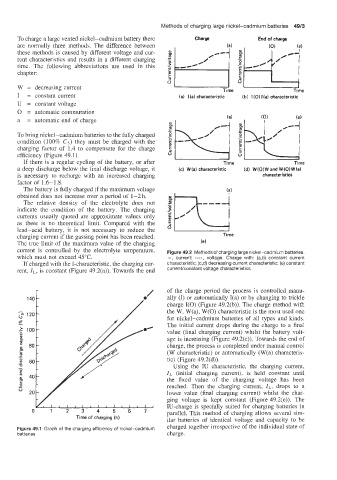Page 502 - Battery Reference Book
P. 502
Methods of charging large nickel-cadmium batteries 49/3
To charge a large vented nickel-cadmium battery there Charge End of charge
are normally three methods. The difference between (a)
these methods is caused by different voltage and cur-
rent characteristics and results in a different charging
time. The following abbreviations are used in this
chapter:
W = decreasing current I Ti me
I = constant current (a) I(a) characteristic (b) I(0) I(a) characteristic
U = constant voltage
0 = automatic commutation
a = automatic end of charge
To bring nickel-cadmium batteries to the fully charged
condition (100% Cs) they must be charged with the
charging factor of 1.4 to compensate for the charge
efficiency (Figure 49.1).
If there is a regular cycling of the battery, or after Time
a deep discharge below the final discharge voltage, it (c) W (a) characteristic
is necessary to recharge with an increased charging
factor of 1.6-1.8.
The battery is fully charged if the maximum voltage
obtained does not increase over a period of 1-2 h.
The relative density of the electrolyte does not
indicate the condition of the battery. The charging
currents usuallly quoted are approximate values only
as there is no theoretical limit. Compared with the
lead-acid battery, it is not necessary to reduce the
charging current if the gassing point has been reached. Ti me
The true limit of the maximum value of the charging (e)
current is controlled by the electrolyte temperature, Figure 49.2 Methods of charging large nickel-cadmium batteries.
which must nlot exceed 45°C. - , current: ----, voltage. Charge with: (a,b) constant current
If charged with the I-characteristic, the charging cur- characteristic; (c,d) decreasing current characteristic: (e) constant
rent; ,TL, is constant (Figure 49.2(a)). Towards the end currentkonstant voltage characteristics
ally (I) or automatically I(a) or by changing to trickle
140 / of the charge period the process is controlled manu-
charge I(0) (Figure 49.2(b)). The charge method with
- i
the W, W(a), W(0) characteristic is the most used one
o* 120 for nickel-cadmium batteries of all types and kinds.
The initial current drops during the charge to a final
value (final charging current) whilst the battery volt-
age is increasing (Figure 49.2(c)). Towards the end of
charge, the process is completed under manual control
(W characteristic) or automatically (W(a) characteris-
tic) (Figure 49.2(d)).
Using the IU characteristic, the charging current,
ZL (initial charging current), is held constant until
the fixed value of the charging voltage has been
reached. Then the charging current, ZL, drops to a
lower value (final charging current) whilst the char-
ging voltage is kept constant (Figure 49.2(e)). The
IU-charge is specially suited for charging batteries in
parallel. This method of charging allows several sim-
Time of charging (h) ilar batteries of identical voltage and capacity to be
Figure 49.1 Graph of the charging efficiency of nickel-cadmium charged together irrespective of the individual state of
batteries charge.

